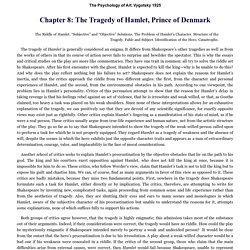

Plant poisons in shakespeare 1970. A Pharmacological Appreciation of Shakespeare's Hamlet (Poison in the Ear).pdf. Rsc_edu_ham_2008_full_pack. Soviet Psychology: Chapter 8: The Tragedy of Hamlet, Prince of Denmark. The Psychology of Art.

Vygotsky 1925 Chapter 8: The Tragedy of Hamlet, Prince of Denmark The Riddle of Hamlet. “Subjective” and “Objective” Solutions. The Problem of Hamlet’a Character. The tragedy of Hamlet is generally considered an enigma. Another school of critics seeks to explain Hamlet’s procrastination by the objective obstacles that lie on the path to his goal. Both groups of critics agree however, that the tragedy is highly enigmatic; this admission takes most of the substance out of their arguments. Let us now consider the enigma of the play. We could continue forever with these excerpts and quotations, since almost all critics dwell on this subject.
All these critics see in the obscurity a mantle that conceals a center, a curtain that hides an image, or a veil that prevents our eyes from seeing the picture underneath. We can therefore disregard all criticism, which tries to separate the enigma from the tragedy and take the veil from the picture. Map.png (PNG Image, 400 × 292 pixels)
Lying and Ethics. Lying By Tim C.

Mazur "I don't dig into people's private lives. I never have. " Ross Perot's brief statement on ABC News in July 1992 was meant to end allegations that he secretly investigated his presidential campaign volunteers. So what? The philosopher Immanuel Kant said that lying was always morally wrong. Lies are morally wrong, then, for two reasons. A second perspective, virtue ethics, also maintains that lying is morally wrong, though less strictly than Kant. Though the nature of virtue ethics makes it difficult to assess the morality of individual acts, those who advocate this theory generally consider lying wrong because it opposes the virtue of honesty. According to a third perspective, utilitarian ethics, Kant and virtue ethicists ignore the only test necessary for judging the morality of a lie - balancing the benefits and harms of its consequences. Recall the son and his dying mother described earlier.
Further Reading. Introduction to Hamlet. Introduction to Hamlet Hamlet, the first in Shakespeare's series of great tragedies, was initially classified as a problem play when the term became fashionable in the nineteenth century.

Like Shakespeare's other problem plays -- All's Well that End's Well, Troilus and Cressida and Measure for Measure -- Hamlet focuses on the complications arising from love, death, and betrayal, without offering the audience a decisive and positive resolution to these complications. This is due in part to the simple fact that for Hamlet, there can be no definitive answers to life's most daunting questions. Indeed, Hamlet's world is one of perpetual ambiguity. Although those around him can and do act upon their thoughts, Hamlet is stifled by his consuming insecurities. The spirit that I have seen May be the devil; and the devil hath power To assume a pleasing shape; yea, and perhaps Out of my weakness, and my melancholy, As he is very potent with such spirits, Abuses me to damn me. (2.2.600-05.) How to write. Embedding Quotes. Shakespeare's Sources for Hamlet: Ur-Hamlet, Revenge tragedy, and the Danish Tragedy.
Shakespeare's Sources for Hamlet Hamlet is based on a Norse legend composed by Saxo Grammaticus in Latin around 1200 AD.

The sixteen books that comprise Saxo Grammaticus' Gesta Danorum, or History of the Danes, tell of the rise and fall of the great rulers of Denmark, and the tale of Amleth, Saxo's Hamlet, is recounted in books three and four. In Saxo's version, King Rorik of the Danes places his trust in two brothers, Orvendil and Fengi. The brothers are appointed to rule over Jutland, and Orvendil weds the king's beautiful daughter, Geruth. They have a son, Amleth. Saxo's story was first printed in Paris in 1514, and Francois de Belleforest translated it into French in 1570, as part of his collection of tragic legends, Histoires Tragiques. Generally, it is accepted that Shakespeare used the earlier play based on this Norse legend by Thomas Kyd, called the Ur-Hamlet.
How to cite this article: Mabillard, Amanda. More Resources O Jephthah - Toying with Polonius. Hamlet.